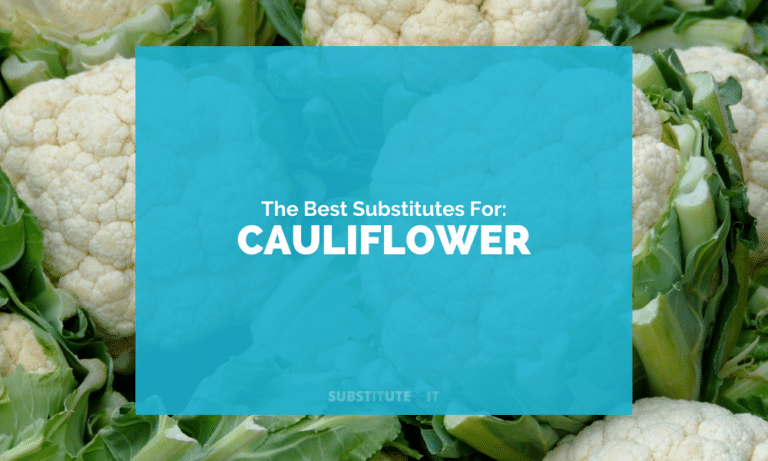Originally from China, cauliflower has been a budget-friendly vegetable used worldwide for years. But in recent years, its usage in recipes has skyrocketed as online health communities have realised its full potential.
It is just as nutritious as other popular brassica family food such as kale, carrying high levels of potassium and iron. Cauliflower is also a low carb food but can really bulk out your dishes.
Our 5 Substitutes for Cauliflower
Compared to other vegetables, cauliflower has quite a bland taste, but this works in its favour! It is easily adaptable to any dish, mainly because of its texture, often used as a substitute for rice or potato.
Here are our top 5 substitutes for cauliflower:
1) Broccoli
Cauliflower and broccoli are often paired together when used as side dishes and are entirely interchangeable.
They both share the same texture and preparation techniques – chop off the various florets from the main stem and cook until soft enough to eat. Because of this, broccoli can be used as a base for rice, potato and soups in the same way that cauliflower can.
You will find that broccoli has a more robust flavour than cauliflower, which is why it is favoured as a stand-alone side ingredient for meats.
This just means that you will not have to work as hard to make broccoli taste delicious.
Remember It’s Green!
Of course, the main difference between broccoli and cauliflower is the intense green colour of broccoli. So long as you are okay with green rice or a splash of colour, this will not be a problem.

2) Courgettes
Though courgettes have a mild flavour, they tend to be more flavoursome than cauliflower. They are a delicate combination of bitter and sweet, so they can be paired well with plenty of dishes.
However, courgettes have a considerably higher water content than cauliflower, so you will need to prepare them a little different to get the cauliflower effect in your dish.
Once you have sliced your courgettes, you can remove some excess moisture by patting the slices with some kitchen towels. Or you could sprinkle some salt over the slices and leave them to sit for a few moments.
The salt will absorb and dry out the courgette slices, giving a better texture when frying or grilling them.
Likewise, you will want to dry out your courgettes if you’re using them when substituting cauliflower rice.
Don’t Over Season
If you use salt to dry out and firm up your courgette slices, make sure to limit the amount of salt you then add to your dish.

3) Cabbage
As a cauliflower substitute, cabbage won’t be acceptable in all recipes. After all, no one was cabbage cheese instead of cauliflower cheese.
Its texture and flavour mean that cabbage will not work well as a base for your dish. However, cabbage will work as a side dish like cauliflower and is an easy way to add extra veg to your plate. Its flavour is mild and adaptable enough to pair well with the main meal without being too filling.
Don’t Overcook!
Cabbage doesn’t take half as long to cook as cauliflower does but is just as easy to prepare. You can use the whole cabbage by chopping it up and dumping it into a pot of boiling water for 5 minutes or so.

4) Asparagus
Extremely high in fibre, asparagus is a desirable vegetable commonly used in lighter dishes. It is best when grilled or sauteed though it can be prepared in many ways.
Keep in mind that asparagus will soften considerably once heated, so do not use it with the intent to replace rice or potato. Instead, use it as a finishing ingredient or a side dish.
The flavour of asparagus is more unique than that of a cauliflower, though it is just as mild.
Try Different Varieties
Asparagus may be mild but try white asparagus if your dish requires more delicate flavours. It tends to be slightly more bitter and milder than green asparagus and will give the same aesthetic as cauliflower on the plate.

5) Parsnips
You will need a sturdy knife to prepare parsnips as they are a lot tougher to cut than most other root vegetables.
Their trickiness is well worth the effort though as their tender and sweet flavour can be paired with both meat and fish with ease. They are best paired with robust dishes to help balance out bitter, rich flavours.
Parsnips can replace cauliflower in most recipes, giving a similar texture once boiled and blitzed.
All Enough Time for Cooking
No matter how you prepare parsnip, their firmness requires a longer cooking time than cauliflower. Especially if you plan to use them as a mash or rice.

Other Substitutes for Cauliflower
Some of the above substitutes can be pretty costly when out of season. Here are a few more that tend to stay budget-friendly all year round:
- Carrots – Essentially a softer parsnip, carrots can similarly replace cauliflower but will not need as long to cook. They are also bright orange, so will alter your dishes’ look considerably.
- Turnips – For bulking out your dish, turnips work brilliantly. It has a robust earthy flavour unlike cauliflower, making it a better pairing for lighter meals.
Summary
If you want to expand your vegetable intake but are getting bored of cauliflower-based meals, you could use plenty of other veggies.
Broccoli is the closest to cauliflower but is just a slightly stronger flavour wise, while asparagus offers a whole new palette that works just as well as cauliflower.
